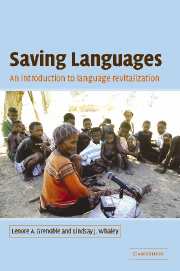1 - Language revitalization as a global issue
Published online by Cambridge University Press: 04 December 2009
Summary
Introduction
Over the past fifty years and with increasing frequency, innovative programs have appeared around the world with the aim of revitalizing languages that are at risk of disappearing due to declining numbers of native speakers. The nature of these initiatives varies as greatly as the languages that are their targets. In some instances, they are nearly national in scope, such as the efforts to preserve Irish, yet in other instances they involve small communities or even a handful of motivated individuals. Many of these programs are connected to claims of territorial sovereignty, though cultural sovereignty or a desire to maintain a unique ethnic identity is just as often the explicit goal. While in one context a revitalization effort may be centered around formal education, in another it may be focused on creating environments in which the language can be used on a regular basis.
Although tremendous variety characterizes the methods of and motives for reinvigorating languages, revitalization, as a general phenomenon, is growing and has become an issue of global proportion. There are now hundreds of endangered languages, and there are few regions of the world where one will not find at least nascent attempts at language revitalization. This comes as little surprise when considered in light of the confluence of several socio-historical factors. First, language death and moribundity (i.e. the cessation of children learning a language) are occurring at an exceptionally rapid rate.
- Type
- Chapter
- Information
- Saving LanguagesAn Introduction to Language Revitalization, pp. 1 - 20Publisher: Cambridge University PressPrint publication year: 2005



